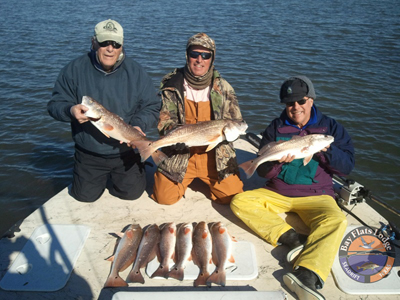
February 9, 2011
I spent the last edition of Guide Lines speaking to you about the importance of having your equipment and gear properly prepared prior to setting out on your first fishing trip of the year. However, there’s one subject I failed to touch upon in that edition, and that would be the important topic of appropriate attire, especially during the month of February which sometimes brings with it some of the coldest days of the year. Now then, February’s a great month for anglers to enjoy solitude while out on the water simply due to the absence of a lot of boat traffic. But by the same token, this month can also mean you might just be on your own for quite some time in the event you are in need of assistance for whatever reason. And there are two things that can only make matters worse on such occasions – being cold, and/or being cold and wet. A most common scenario of this would be that you’ve just left the boat ramp and are making your way across the bay at some 30-40mph when you suddenly discover that you’re not wearing enough clothing to keep you warm for the entirety of the ride to your first destination. Now, this problem is quickly remedied by putting on more clothing (if you have more to put on). But an even better remedy would have been for you to have worn several layers of clothing to begin with, remembering that you can always shed some clothes if you must, but that you can’t put on extra clothes if you don’t have them. A different, and perhaps more extreme, scenario might play out at the end of your fishing day while returning to the boat after your final wade session, during which time you had suffered a brief stumble in a deep pothole that resulted in you filling your chest-waders with chilling water. You either didn’t have a belt around the waist of your waders, or in your haste to start fishing had forgotten to wear it. Regardless, all you clothes are now wet, but it didn’t feel too bad while you were out wading. You’re now at the boat and out of the water, and suddenly your body begins to shiver uncontrollably. Just when you think your day couldn’t get any worse, you turn the key to start the outboard and nothing happens. The end of daylight is rapidly approaching, and there’s not another boat in sight. The fact that the motor won’t start is a problem that you may, or may not, end up needing assistance with. However, you being wet to the bone in extremely cold weather will mean you’re definitely going to need assistance in the event you have no means by which to get warm. Wouldn’t it have been nice had you thought to have packed an extra set of dry clothes? Failure to do so, in such conditions, could just turn out to be life threatening in an extraordinary situation. Besides making good sense, having dry clothes on your body means you’ll be more comfortable, and being comfortable means you’ll probably be able and willing to fish for a longer period of time throughout the course of a long, cold February day.
Now, back to fishing! Cold weather usually provides us with a lull in the tides, so in my hopes of making direct contact with some really nice trout in February I’ll be focusing on working my baits very slow at these times amidst mud and grass in shoreline coves and protected bayous, channels, and drains that I find leading out of back lake areas. In the event of a high tide situation, you’ll find me searching for bait in some of the more remote regions of the back lakes – fishing along the windward shorelines of the lakes during high tides. Higher tides usually result in off-colored waters in the backcountry, but there will typically be a lot of bait that has been driven against the shoreline.
When targeting these large trout, the first choice out of my bait arsenal has historically been suspending lures like that of the Corky Fat Boy in one of my more preferred colors like green/black or solid bone. Top water baits are also big producers at this time in the year, and you’ll find me throwing a wide variety of patterns, but in smaller sizes, as I’ve found it to be a lot easier to work the smaller surface baits in winter’s sometime high-wind conditions. I also will not disregard soft plastics during this period, as they certainly have yielded full stringers for me in February. But regardless of the bait I choose on any given wintertime day, I’ve found it to be very important for me to keep in mind that I should choose the bait which I’ve found I have the most confidence in. I’ll rig that lure and will usually stick with it throughout my entire day of fishing. I’ve found that by fishing with the same lure all day that I, naturally, minimize my number of lure changes, but that I also maximize the comfort level I have with my pre-selected bait, especially when I feel that there definitely are fish in the area that I’ve chosen. Cold water trout are lethargic, and they may eat only once each day, so don’t expect a lot of quick action during periods of extreme February cold. Keep grinding!
In closing, don’t forget about the 2011 WINTER FISHING SPECIAL at Bay Flats Lodge during February and March when you and your guests can fish each day of the week at tremendously discounted rates and have a chance to win some really great prizes. Please phone or email me to learn more about these special BFL events. Remember to practice CPR, “Catch, Photo, and Release”, whenever possible on trophy Trout and Reds…Guide Chris Martin, Port O’Connor/Seadrift region. www.BayFlatsLodge.com…1-888-677-4868
